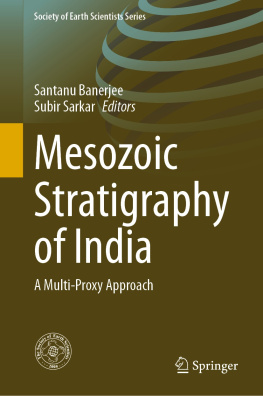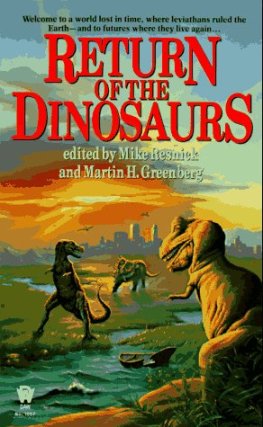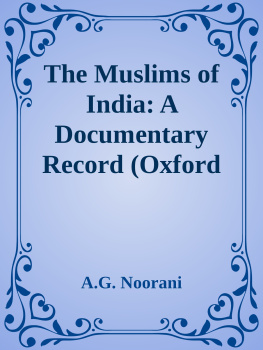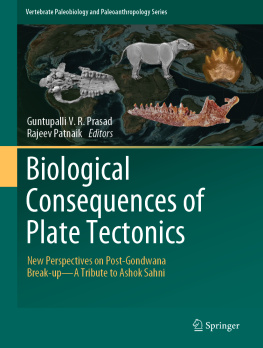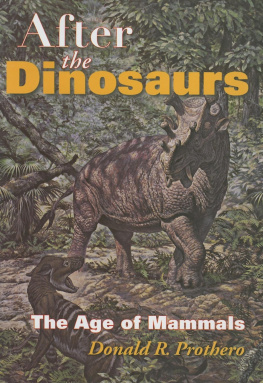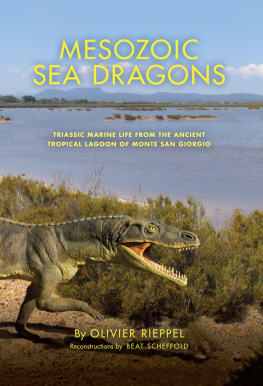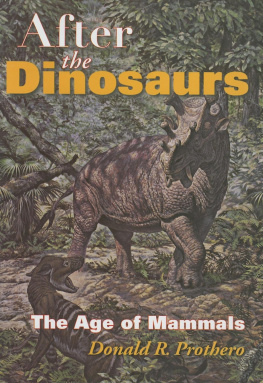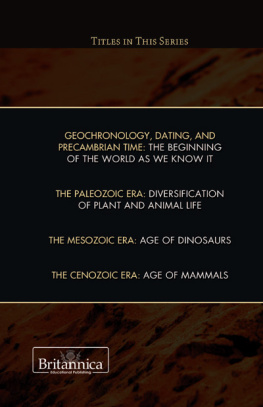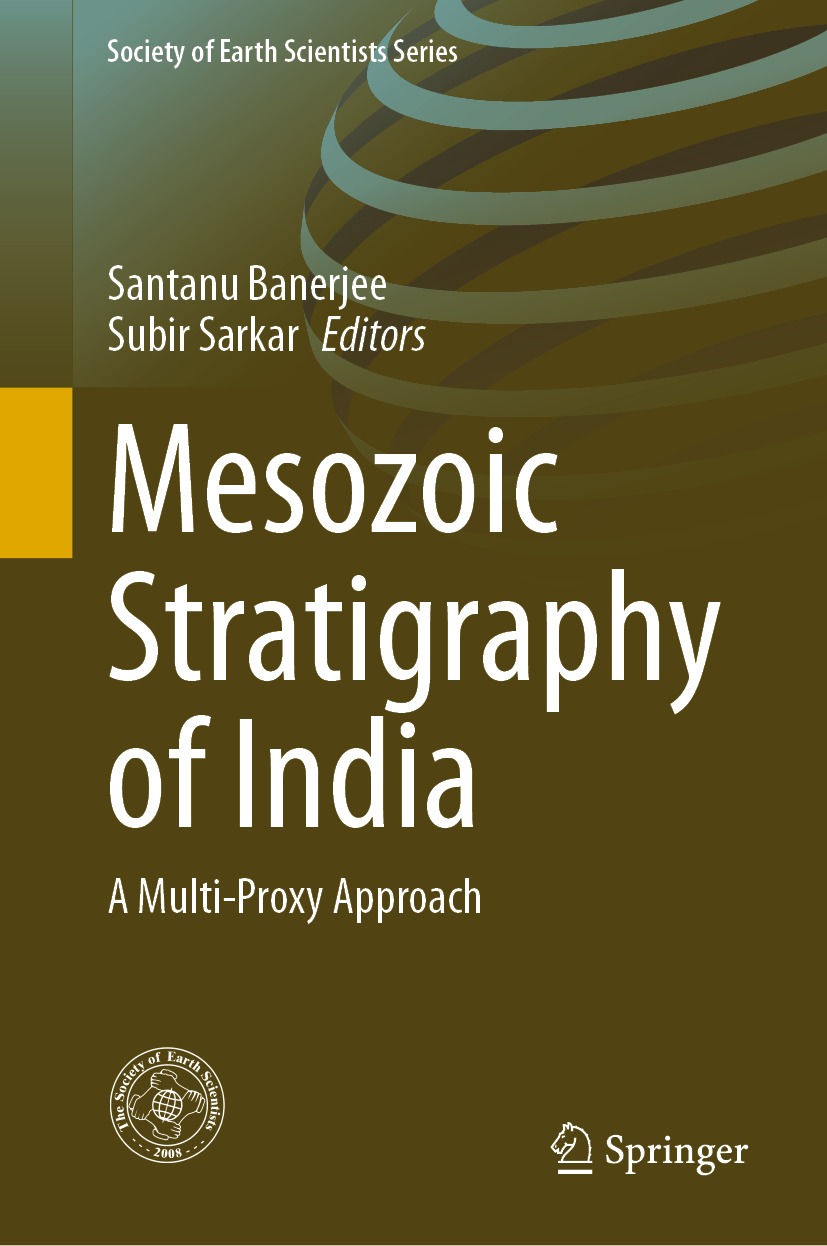Society of Earth Scientists Series
Series Editor
Satish C. Tripathi
Lucknow, India
The Society of Earth Scientists Series aims to publish selected conference proceedings, monographs, edited topical books/text books by leading scientists and experts in the field of geophysics, geology, atmospheric and environmental science, meteorology and oceanography as Special Publications of The Society of Earth Scientists. The objective is to highlight recent multidisciplinary scientific research and to strengthen the scientific literature related to Earth Sciences. Quality scientific contributions from all across the Globe are invited for publication under this series. Series Editor: Dr. Satish C. Tripathi
More information about this series at http://www.springer.com/series/8785
Editors
Santanu Banerjee and Subir Sarkar
Mesozoic Stratigraphy of India
A Multi-Proxy Approach
1st ed. 2021

Logo of the publisher

Logo of the publisher
Editors
Santanu Banerjee
Department of Earth Sciences, Indian Institute of Technology Bombay, Mumbai, India
Subir Sarkar
Department of Geological Sciences, Jadavpur University, Kolkata, India
ISSN 2194-9204 e-ISSN 2194-9212
Society of Earth Scientists Series
ISBN 978-3-030-71369-0 e-ISBN 978-3-030-71370-6
https://doi.org/10.1007/978-3-030-71370-6
The Editor(s) (if applicable) and The Author(s), under exclusive license to Springer Nature Switzerland AG 2021
This work is subject to copyright. All rights are solely and exclusively licensed by the Publisher, whether the whole or part of the material is concerned, specifically the rights of translation, reprinting, reuse of illustrations, recitation, broadcasting, reproduction on microfilms or in any other physical way, and transmission or information storage and retrieval, electronic adaptation, computer software, or by similar or dissimilar methodology now known or hereafter developed.
The use of general descriptive names, registered names, trademarks, service marks, etc. in this publication does not imply, even in the absence of a specific statement, that such names are exempt from the relevant protective laws and regulations and therefore free for general use.
The publisher, the authors and the editors are safe to assume that the advice and information in this book are believed to be true and accurate at the date of publication. Neither the publisher nor the authors or the editors give a warranty, expressed or implied, with respect to the material contained herein or for any errors or omissions that may have been made. The publisher remains neutral with regard to jurisdictional claims in published maps and institutional affiliations.
This Springer imprint is published by the registered company Springer Nature Switzerland AG
The registered company address is: Gewerbestrasse 11, 6330 Cham, Switzerland
We dedicate this book to Prof. Pradip K. Bose
Series Editor Foreword
Mesozoic sedimentary sequences of India were deposited in intra-cratonic and peri-cratonic tectonic basins, and sensitively recorded palaeoclimatic changes and oceanland life. The pile of almost undisturbed Mesozoic sediments is punctuated by marine transgressionregression events and are most suitable for sequence stratigraphic studies. Sedimentation under the influence of tectonism, plate movement and climatic variability ended with a well-known mass extinction event leading to the demise of gigantic dinosaurs. The large parts in Central India are covered by Deccan lava flows obscuring the infratrappean geological set-up. Economic petroleum resources within Mesozoic sequences make them so important.
Owing to excellent palaeontological records, some of the basins like Kutch, Jaisalmer, Spiti and Cauvery were extensively studied. The dinosaur fossil hunting grounds of Mesozoics are a paradise for vertebrate palaeontologists. The evidence of K/Pg mass extinction and outburst of basaltic lava covering a large part of the geology of India are significant global events. The Gondwana Mesozoic sedimentary basins are another thick largely continental sediments affected by tectonism. The geological datasets obtained from Gondwana sediments are of international significance. I hope this book on the Mesozoic stratigraphy of India employing various proxies will bring out new results and open new vistas. I sincerely thank editors and contributors for bringing out this volume.
Series Editor
Satish C. Tripathi
Lucknow, India
Preface and Acknowledgements
Mesozoic sedimentary rocks of India record the effects of abnormal sea level rise, greenhouse climate, intensified volcanism, hypoxia in seawater and extensive black shale deposition. Mesozoic time also witnessed the mass extinction events, the evolution of dinosaurs and the breakdown of the supercontinent Pangea, followed by the formation of Gondwana. The Mesozoic record is particularly significant for the industry as more than 75% of oil and gas formed during this time. The Mesozoic record of India has been investigated thoroughly from biostratigraphic and lithostratigraphic viewpoints in the last century. Literature survey, however, reveals significant gaps in knowledge regarding sedimentology, sequence stratigraphy, chemostratigraphy and some major geological events during the Mesozoic. This book envisages a multi-proxy approach using detailed sedimentological analysis, floral and faunal assemblage, geochemical proxies, magnetic susceptibility, stable isotopes and associated biotic events for paleoclimatic and the paleoenvironmental interpretations of the Mesozoic sedimentary record of India. The book focuses on recent findings on lithostratigraphy, chemostratigraphy, biostratigraphy, magnetostratigraphy and sequence stratigraphy of Mesozoic basins of India, including Kutch, Cauvery, Krishna-Godavari, Jaisalmer and Narmada basin and Spiti valley. The edited volume highlights the present understanding regarding stratigraphical and depositional histories of Mesozoic sedimentary basins in the backdrop of global tectono-thermal events and sea-level changes. A thorough biostratigraphic investigation of the sedimentary deposits provides high-resolution interpretations of the Mesozoic basins. A synthesis of sedimentological, palaeontological and chemical data using the multi-proxy approach provides a comprehensive understanding of the Indian Mesozoic record to the students, researchers and professionals. Information presented in this book not only benefits academicians but is also relevant for the oil and gas industry.
This book comprises 23 chapters covering most of the Mesozoic sedimentary basins in the peninsular and extra-peninsular regions of India; more than half of which are from Kutch, Cauvery and Jaisalmer basins. The first two chapters of this book present reviews of stratigraphy, sedimentation history and paleogeography of Mesozoic basins in India. The first chapter (Singh et al.) presents a detailed petrographical and mineralogical analysis of the latest Cretaceous red bole beds, interlayered with Deccan Basalt in western India. The study indicates several breaks during the eruption of Deccan Basalt, which lead to the formation of volcanic paleosol at places.

